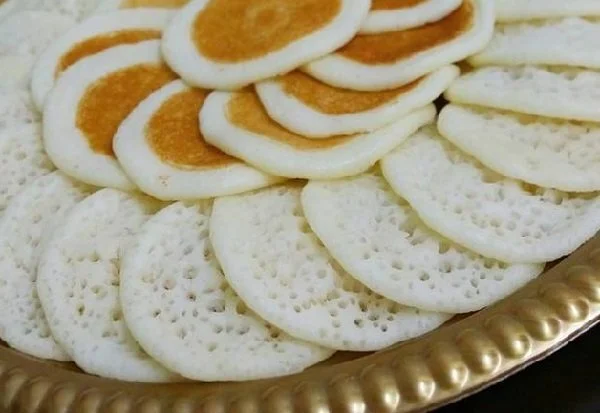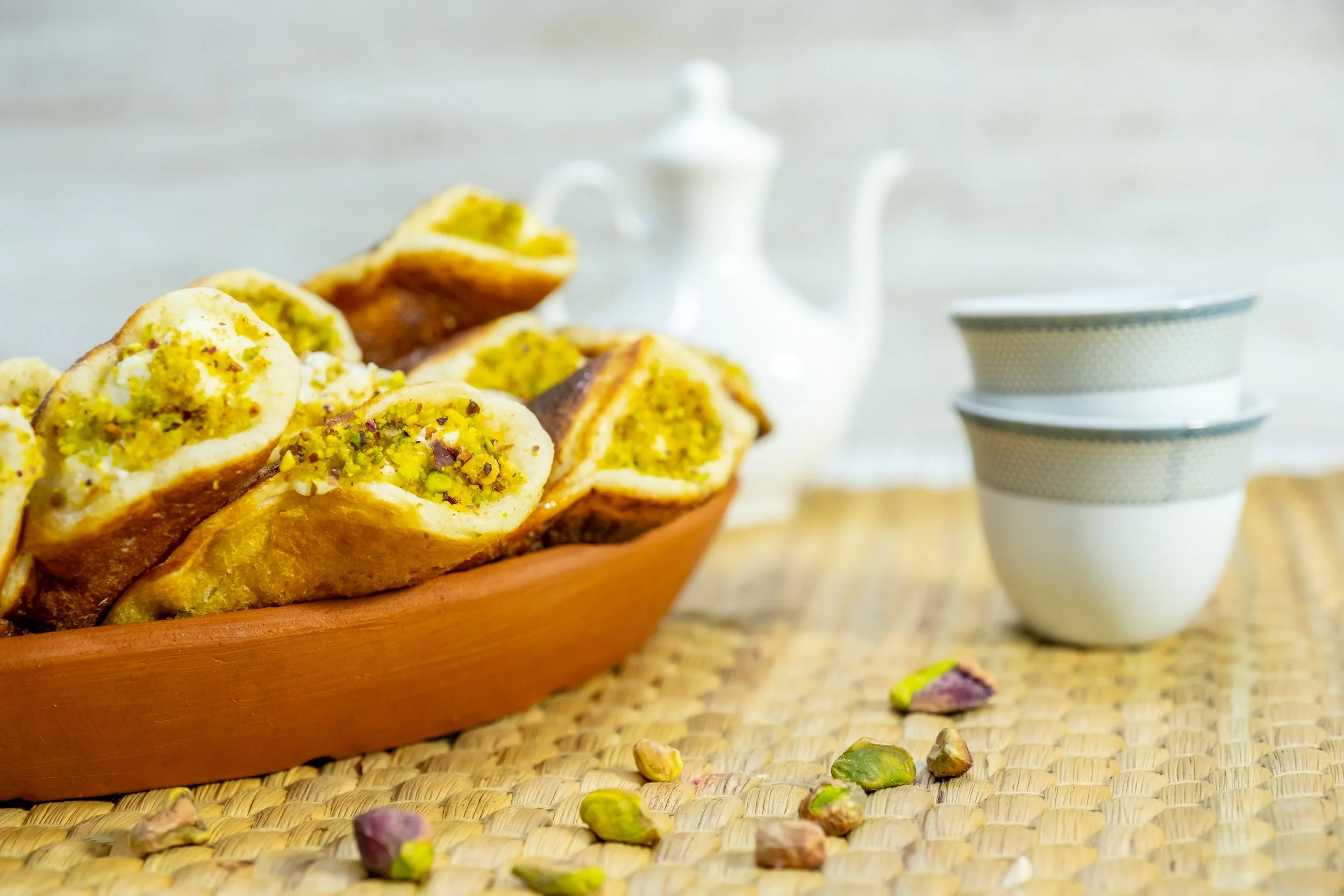That Translator Can Cook: Qatayef
A thin miniature pancake that was fully cooked without flipping so that one side is bubbly. It is then stuffed with either Akkawi cheese or walnuts and cinnamon; deep fried; drizzled with honey/syrup or sprinkled with powdered sugar; and topped with crushed pistachios.
Image Source: Freepik
These qatayef depicted to the right are the ones that are stuffed with walnuts, but qatayef with cheese also look pretty much the same (from the outside).
Image Source: Tareekaa
I looooove qatayef, or ‘atayef in some dialects. I prefer the walnut ones and I like it when they are not drenched in syrup, but to each their own. I have been able to buy them when it’s not Ramadan, but Ramadan is when they are really popular. I’ve also spent a summer in Jordan, when Ramadan fell right in the middle of my stay: street vendors started making these little pancakes by the hundreds so that people could take them home and make their own qatayef.
Image Source: Freepik
There are three main types of qatayef: (1) qatayef bil-jibna (qatayef with cheese), which is deep fried qatayef with an Akkawi cheese filling; (2) qatayef bil-joz (qatayef with walnuts), which is deep fried qatayef with a cinnamon walnut filling; and (3) qatayef asafiri (mini qatayef), which qatayef that’s only half closed and filled with ashta (cream) or qishta (clotted cream)-they are not fried. Ashta and qishta seem to be the same thing, but when I search for ashta, it seems to be referred to as ‘sweet’ and as ‘whipped cream’, whereas qishta, while featured in dessert recipes, is referred to as ‘clotted cream.’ I should also mention that other types of nuts (i.e. almonds, etc.) often replace walnuts. Technically, there’s only two types of qatayef (regular and mini), and the regular form comes in two flavors, but I like to think of them as three separate types. While qatayef asafiri are made/sold in the Levant, I believe they’re more popular in Egypt.
According to Chef Sawsan Abu Farha, cooking the pancakes so that one side is bubbly allows the flavor of the filling to permeate the pancake. She continues to describe how the different flavors have different textures: the melted sweet cheese filling of qatayef bil-jibna complements the crunchy exterior; the crunchy cinnamon walnut filling of qatayef bil-joz plays off the crunchy exterior; and the qatayef asafiri are soft and velvety because of the smooth cream filling and the pancake hasn’t been fried. Her stories and experiences are wonderful and she shows you how to deal with making the pancakes from scratch and soften the cheese, so I hope you all take a look at her page with the link above after you’re done here.
‘Qatayef’ derives from the Arabic verb ‘qatafa’, which means “to pick up” because if given the choice of desserts, you’ll definitely pick up qatayef 😉 It is thought that qatayef were created in the Fatimid Caliphate (909-1171), but they actually originated in the Abbasid Caliphate (661-1258) and were referenced in a 10th century cookbook. According to Cairo360, Umayyad Caliph Sulaiman ibn Abdul Malik was supposedly the first person ever to eat qatayef in 98 AH (717 CE). Besides their interesting history, qtayaef serves as a delicious treat after a long day of fasting. The sight of these little pancakes evokes warm fuzzy feelings and gets people excited for Ramadan!
Here is how to qatayef with cheese (recipe belongs to Hiyam Hawa) and qatayef with walnuts (recipe belongs to Naseem al-Bahar [نسيم البحر]), and qatayef with qishta (recipe belongs to Nahida Da7son Chahin).
Qatayef with Cheese
Ingredients
1 kilo of qatayef [pancakes]
0.5 kilo of sweet cheese
2 tablespoons of sugar
1 teaspoon of qizha [black cumin seed paste] (fennel flower) or to taste
For making the syrup
3 cups of sugar
3 cups of water
Lemon juice
1 tablespoon of rose water
2 large cups (4 measuring cups?) of oil for frying
Instructions
Take the cheese and mash it with a fork, then add the sugar and qizha to it. Mix it all together, stuff the pancakes, and arrange them in a frying pan. Add oil to the pan on the stove and heat it to fry some qatayef, then arrange them on a paper towel to absorb all the oil. Make the syrup—turn off the burner when it thickens. After the oil is absorbed from the stuffed qatayef, dunk them in the lukewarm syrup and arrange them on a serving platter. Bon appetite!
Qatayef with Walnuts
Ingredients
1 kg of pre-prepared qatayef pancakes
1/2 kilo of crushed walnuts
Ground cinnamon to taste
The syrup or sirup:
4 cups of sugar
2 cups of water
A dash of lemon juice
Instructions
The first thing is to mix the cinnamon with the walnuts and start stuffing the qatayef pancakes. Press the edges together really well so that the filling doesn't ooze out during frying. After finishing that, deep-fry them in vegetable oil. You can also baste them with oil and bake them in the oven if you want.
Immediately after frying the qatayef, prepare the syrup and it’s better if it’s cool. You can add cinnamon and a tablespoon of ghee to the syrup to dip the qatayef in. Bon appetite!
Qatayef with Qishta
Ingredients
3 cups of flour
2 tablespoons of sugar
1.5 tablespoons of yeast
3 tablespoons of baking powder
A little bit of lukewarm water
1 can of qishta [clotted cream] (170g/~6 oz.)
1 cup of syrup for serving
Instructions
Put all the dry ingredients in a bowl and add a tiny bit of water whisking until the batter becomes a thick like yogurt. Cover it and let it ferment for an hour and a half. Heat a non-stick frying pan and cook the qatayef pancakes. When they cool, stuff them with the qishta. Garnish them and serve them with the syrup. Bon appetite!
Translators’ Discussion
Based on context, it seems like ‘qatayef’ can refer to the finished product or the little pancakes you stuff. What do Arabic speakers think?
I didn’t want to put ‘2 large cups’, but كاستين كبار was what was written and I wasn’t sure what exactly a big cup is. I’m assuming that they used different sized glasses when making qatayef. Does anyone have any thoughts about this?
I had a bit of trouble with this sentence from the qatayef with cheese recipe: بنعمل القطر وليتعئد بنطفي تحتو. How would you have translated this?
I wasn’t really sure what عصرة ليمون خفيفة meant exactly, which is why I originally translated it as ‘pulp-free lemon juice’. Am I missing something?
I decided to cut out بسم الله الرحمن الرحيم (In the name of God, the Most Gracious, the Most Merciful) because it wouldn’t make sense in an English recipe and doesn’t really have any equivalents. I suppose I should have kept it since it’s Ramadan. Any advice?
I wrote ‘syrup or sirup’ because the recipe stated “القطر أو الشيره”-both mean syrup, unless I’m mistaken?



